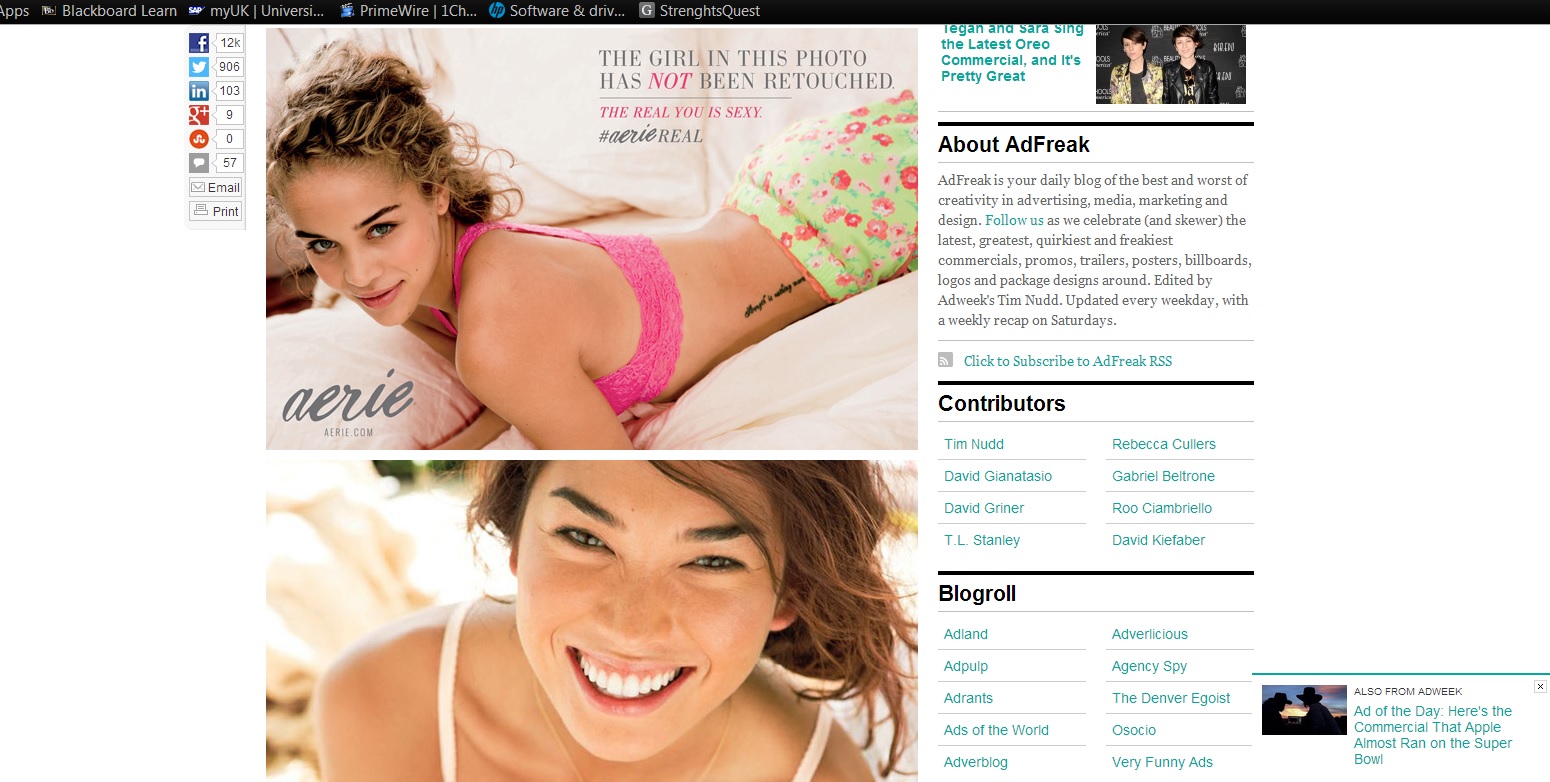On January 17, 2014, Aerie by American Eagle launched a campaign entitled #AerieReal. The company, which predominantly sells bras, underwear, and athletic apparel, vowed to no longer use Photoshopped and otherwise retouched images of women in their advertising campaigns. Prior to this announcement, which formally occurred to email subscribers and on Good Morning America, Aerie admitted to having used photo editing software to digitally enhance the images of models that graced their storefronts and web page. Aerie is far from the only guilty company marketing to young women (approximately 15-22 years of age), but the company’s bold promise to abstain from photo editing is an important stride for adolescents approaching womanhood. Because access to media content and advertisements has been exponentially perpetuated by the creation of numerous social media sites, teen girls are constantly bombarded with images insinuating what defines the perfect body type. In reality, the supermodel persona that #AerieReal is attempting to combat depicts a body figure that is largely unattainable for many women due to genetic predisposition of weight and height. By implying that supermodel body types are not “real”, Aerie intends to show young women that they are beautiful, regardless of their shape.
Regardless, however, is the key word that promotes critical analysis of Aerie’s new campaign. #AerieReal is not the first campaign of its kind; Dove, American Apparel, among other companies have used similar tactics to dismiss the notion in popular culture that women must resemble a Victoria’s Secret Angel to be acknowledged as beautiful. Aerie’s campaign differs slightly in the sense that its target audience is adolescent and college-age women as opposed to the established working woman or mother figure. #AerieReal, at first glance, appears to be a revolutionary campaign for young women that challenges deeply rooted beauty norms and subsequent trends of consumerism. While the advocacy is progressive, Aerie has far from accomplished its goal of being representative of “real” women’s bodies. It must be noted that Aerie is a for profit company that must employ popular advertising strategies to remain a frontrunner in the competitive lingerie market. A closer examination of the photos accompanying the new campaign’s launch is said to include the “natural” aspects of a woman’s body such as tattoos, tan lines, dimples, and cellulite, thus implying imperfections are not only acceptable, they are unique, beautiful, and sexy. While tan lines and tattoos are evident within the campaign’s photos, the alleged blemishes and imperfections on the women’s bodies are far from the cellulite many young women viewing this campaign cope with daily.
The models Aerie has selected are, of course, real women and appear unretouched in the photographs, yet it is likely these women are close to flawless anyways, outside of the advertiser’s context. Thus, the regardless clause implied in the campaign’s tagline, The Real You is Sexy, becomes questionable. Furthermore, the women representing the campaign are would still be considered beautiful by today’s standards for their natural, flowing hair, glowing skin, and seductive curves. There are limited racial identifiers within the campaign because many of the women shown appear to be racially ambiguous with dark hair, sun-kissed skin, and otherwise exotic features that cannot be specifically attributed to the most common racial binary of black and white. Are the women in the advertising campaign truly representative of the target audience or is this another botched attempt of equal representation and promotion of body confidence?
Aerie’s products, in and of themselves, promote sex appeal and the commodification of bodies. By suggesting that young girls and women are sexy as they are yet still need the company’s lingerie presents a logical fallacy consumers often fail to see. Essentially, the actual advertising strategy employed, of preying on young girls’ poor self-concept and low self esteem, is masked by the seemingly real images of women offered by the company. Aerie’s commentary on the campaign has been minimal — the site offers a brief description of what #AerieReal intends to showcase and features short video segments about the photo shoots with the new, real models. Perhaps, Aerie’s impact would appear more genuine if the company had released commentary on the images young women view that are so skewed and can and have caused real physical danger through body manipulation and dismorphic disorder. Aerie’s commitment to only use real models in opposition to supermodels employed by companies such as Victoria’s Secret further distances viewers from the idea that all women are women, regardless of body shape and type. Although some supermodels have had surgical procedures, undergone serious body modifications, or live by their fitness regimens, they are still women nonetheless and cannot be excluded from the conversation. Aerie must be sensitive of how they define a “real” woman because the campaign could just as quickly isolate women on each end of the beauty spectrum also seeking solidarity and body confidence.
Although #AerieReal marks an important stride in the advertising market’s acknowledgement of perpetuated stereotypes regarding female bodies, the company must continue to advocate for the issue if they wish to enact true change and to eliminate poor self-concept based on appearance. A look at Aerie’s website today leaves room for suspicion. Launching a new line of swimwear, Aerie’s model on the main interface of the website appears absolutely flawless. Slender, tan, and toned, the model’s only noticeable “imperfection” is the slightest bit of a tattoo peeking out of her bathing suit bottoms. Additionally, Aerie’s Valentine’s Day collection subtlely promotes heterosexuality as the norm with questionable email subject lines implying that their products are purchased for someone other than yourself, namely a male. Such an advertisement directly contradicts the #AerieReal commitment to self-empowerment. If Aerie desires to be a groundbreaking company and to radically change the face of advertising and its portrayal of women, the company must continue developing their sensitivity to real issues facing real women across America.
View the campaign on Aerie’s homepage here.
